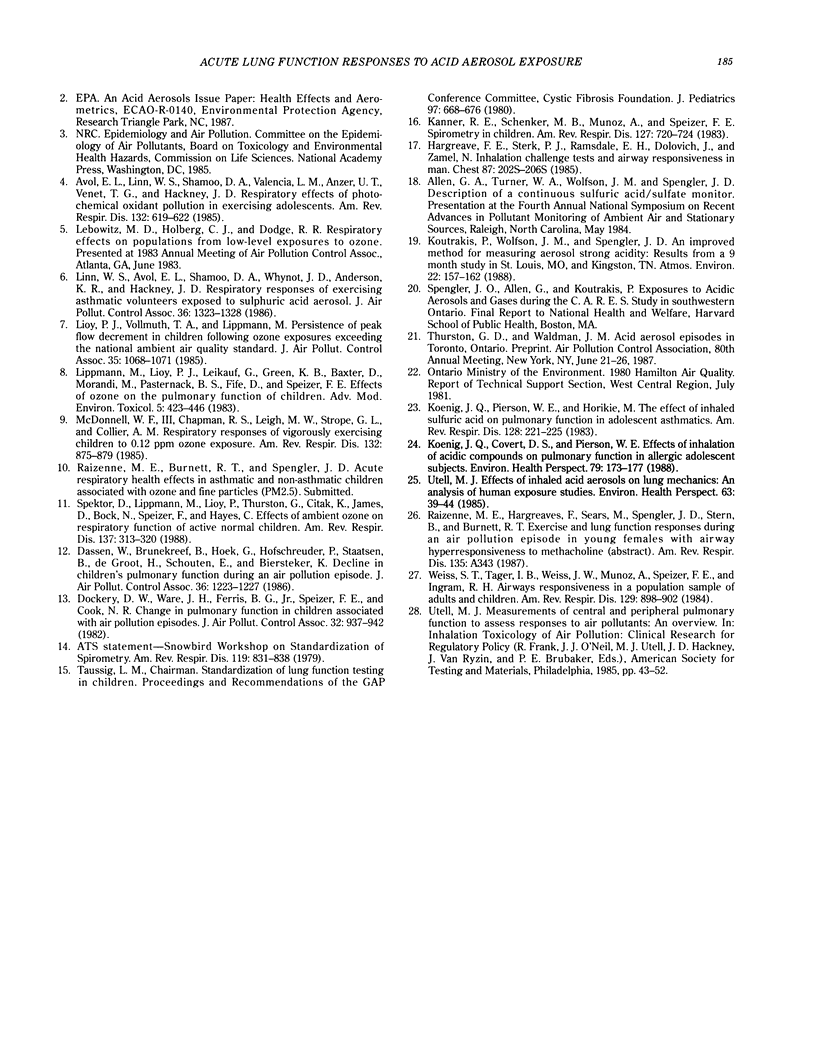Abstract
We examined the relationship between lung function changes and ambient acid aerosol episodes in children attending a residential summer camp. Young females (112) performed daily spirometry, and 96 were assessed on one occasion for airway hyperresponsiveness using a methacholine bronchoprovocation test. Air quality measurements were performed on site and four distinct acid aerosol episodes were observed during the 41-day study. The maximum values observed during the 41-day study were: O3 at 143 ppb; H2SO4 at 47.7 micrograms/m3; and [H+] at 550 nmole/m3. Maximum decrements of 3.5 and 7% for FEV1 and PEF, respectively, were observed to be associated with the air pollution episodes. There was some evidence of a differential lung function response to the episodes where children with a positive response to a methacholine challenge had larger decrements compared to their nonresponsive counterparts.
Full text
PDF






Selected References
These references are in PubMed. This may not be the complete list of references from this article.
- Avol E. L., Linn W. S., Shamoo D. A., Valencia L. M., Anzar U. T., Venet T. G., Hackney J. D. Respiratory effects of photochemical oxidant air pollution in exercising adolescents. Am Rev Respir Dis. 1985 Sep;132(3):619–622. doi: 10.1164/arrd.1985.132.3.619. [DOI] [PubMed] [Google Scholar]
- Dassen W., Brunekreef B., Hoek G., Hofschreuder P., Staatsen B., de Groot H., Schouten E., Biersteker K. Decline in children's pulmonary function during an air pollution episode. J Air Pollut Control Assoc. 1986 Nov;36(11):1223–1227. doi: 10.1080/00022470.1986.10466168. [DOI] [PubMed] [Google Scholar]
- Dockery D. W., Ware J. H., Ferris B. G., Jr, Speizer F. E., Cook N. R., Herman S. M. Change in pulmonary function in children associated with air pollution episodes. J Air Pollut Control Assoc. 1982 Sep;32(9):937–942. doi: 10.1080/00022470.1982.10465494. [DOI] [PubMed] [Google Scholar]
- Kanner R. E., Schenker M. B., Muñoz A., Speizer F. E. Spirometry in children. Methodology for obtaining optimal results for clinical and epidemiologic studies. Am Rev Respir Dis. 1983 Jun;127(6):720–724. doi: 10.1164/arrd.1983.127.6.720. [DOI] [PubMed] [Google Scholar]
- Koenig J. Q., Covert D. S., Pierson W. E. Effects of inhalation of acidic compounds on pulmonary function in allergic adolescent subjects. Environ Health Perspect. 1989 Feb;79:173–178. doi: 10.1289/ehp.8979173. [DOI] [PMC free article] [PubMed] [Google Scholar]
- Koenig J. Q., Pierson W. E., Horike M. The effects of inhaled sulfuric acid on pulmonary function in adolescent asthmatics. Am Rev Respir Dis. 1983 Aug;128(2):221–225. doi: 10.1164/arrd.1983.128.2.221. [DOI] [PubMed] [Google Scholar]
- Linn W. S., Avol E. L., Shamoo D. A., Whynot J. D., Anderson K. R., Hackney J. D. Respiratory responses of exercising asthmatic volunteers exposed to sulfuric acid aerosol. J Air Pollut Control Assoc. 1986 Dec;36(12):1323–1328. doi: 10.1080/00022470.1986.10466181. [DOI] [PubMed] [Google Scholar]
- Lioy P. J., Vollmuth T. A., Lippmann M. Persistence of peak flow decrement in children following ozone exposures exceeding the National Ambient Air Quality Standard. J Air Pollut Control Assoc. 1985 Oct;35(10):1069–1071. [PubMed] [Google Scholar]
- McDonnell W. F., 3rd, Chapman R. S., Leigh M. W., Strope G. L., Collier A. M. Respiratory responses of vigorously exercising children to 0.12 ppm ozone exposure. Am Rev Respir Dis. 1985 Oct;132(4):875–879. doi: 10.1164/arrd.1985.132.4.875. [DOI] [PubMed] [Google Scholar]
- Spektor D. M., Lippmann M., Lioy P. J., Thurston G. D., Citak K., James D. J., Bock N., Speizer F. E., Hayes C. Effects of ambient ozone on respiratory function in active, normal children. Am Rev Respir Dis. 1988 Feb;137(2):313–320. doi: 10.1164/ajrccm/137.2.313. [DOI] [PubMed] [Google Scholar]
- Taussig L. M., Chernick V., Wood R., Farrell P., Mellins R. B. Standardization of lung function testing in children. Proceedings and Recommendations of the GAP Conference Committee, Cystic Fibrosis Foundation. J Pediatr. 1980 Oct;97(4):668–676. doi: 10.1016/s0022-3476(80)80039-4. [DOI] [PubMed] [Google Scholar]
- Utell M. J. Effects of inhaled acid aerosols on lung mechanics: an analysis of human exposure studies. Environ Health Perspect. 1985 Nov;63:39–44. doi: 10.1289/ehp.856339. [DOI] [PMC free article] [PubMed] [Google Scholar]
- Weiss S. T., Tager I. B., Weiss J. W., Munoz A., Speizer F. E., Ingram R. H. Airways responsiveness in a population sample of adults and children. Am Rev Respir Dis. 1984 Jun;129(6):898–902. doi: 10.1164/arrd.1984.129.6.898. [DOI] [PubMed] [Google Scholar]


